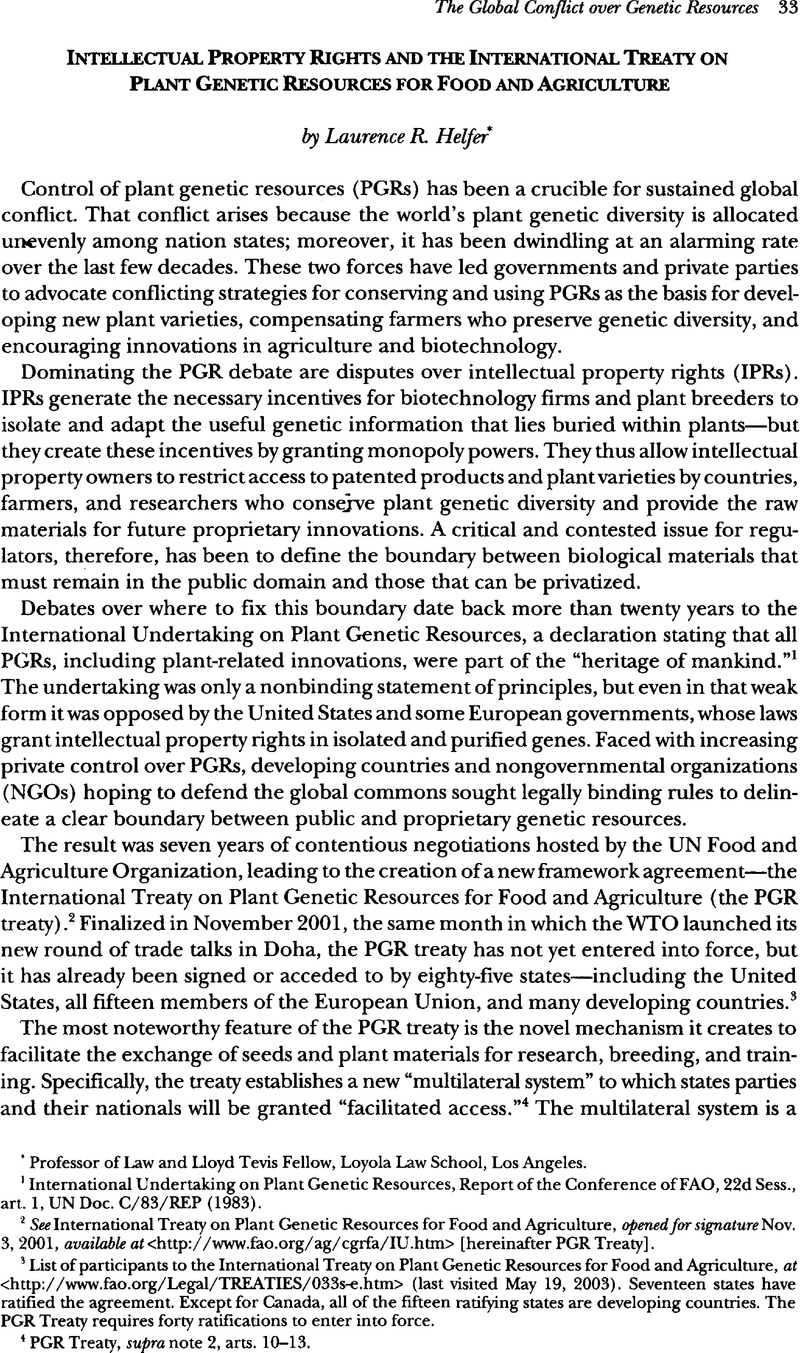Article contents
Intellectual Property Rights and the International Treaty on Plant Genetic Resources for Food and Agriculture
Published online by Cambridge University Press: 28 February 2017
Abstract

- Type
- The Global Conflict Over Genetic Resources
- Information
- Copyright
- Copyright © American Society of International Law 2003
References
1 International Undertaking on Plant Genetic Resources, Report of the Conference of FAO, 22d Sess., art. 1, UN Doc. C/83/REP (1983).
2 See International Treaty on Plant Genetic Resources for Food and Agriculture, opened for signature Nov. 3, 2001, available at <http://www.fao.org/ag/cgrfa/IU.htm> [hereinafter PGR Treaty].
3 List of participants to the International Treaty on Plant Genetic Resources for Food and Agriculture, at <http://www.fao.org/Legal/TREATIES/033s-e.htm> (last visited May 19, 2003). Seventeen states have ratified the agreement. Except for Canada, all of the fifteen ratifying states are developing countries. The PGR Treaty requires forty ratifications to enter into force.
4 PGR Treaty, supra note 2, arts. 10-13.
5 Rose, Carol M., The Several Futures of Property: Of Cyberspace and Folk Takes, Emission Trades and Ecosystems, 83 Minn. L. Rev. 129, 132 (1998 Google Scholar) (defining “limited common property” as “property held as commons among the members of a group, but exclusively vis-à-vis the outside world”).
6 PGR Treaty, supra note 2, Annex I (listing thirty-five food and twenty-nine feed crops).
7 Payments are mandatory when the commercialized product has limits on its availability for use in further research and breeding, but voluntary when the product is freely available for such purposes. Id. art. 13.2(d) (ii).
8 The PGR treaty provides for a variety of benefit-sharing mechanisms, among them exchange of information, access to and transfer of technology, capacity building, and the sharing of benefits arising from commercialization. Id., arts. 13, 18.
9 UN Conference on Env’t & Dev., Convention on Biological Diversity, UNEP/Bio.Div./N7-INC5/4, reprinted in 31 ILM 818 (1992). As of December 2002, 187 states had ratified the Convention. See Parties to the Convention on Biological Diversity, available at <http://www.biodiv.org/world/parties.asp>.
10 PGR Treaty, supra note 2, art. 12.3 (d). This same ban must be included in standardized material transfer agreements that all private parties seeking to access the multilateral system must execute. Id., art. 12.4.
11 For a discussion of the negotiating history, see Heifer, Laurence R., Intellectual Property Rights in Plant Varieties: An Overview with Options for National Governments, in Fao Legal Papers Online #31, at 51 (July 2002)Google Scholar, available at <http://www.fao.org/Legal/pub-e.htm>.
12 Material transfer agreements, sometimes referred to as biodiversity prospecting contracts, are agreements between national governments or indigenous peoples that own or control access to genetic resources and commercial entities seeking access to those resources. See id. at 10.
13 To aid the Governing Body in this drafting work, the Commission on Genetic Resources has convened a panel of experts to recommend terms to be included in a standard material transfer agreement. First Meeting of the Comm’n on Genetic Res. for Food & Agrie, acting as Interim Committee of the Int’l Treaty on Plant Geneüc Res. for Food & Agrie, Cgrfa-MIC-1/02/REP, App. D (Oct. 9-11, 2002), available at <http://www.fao.org/ag/cgrfa/docsic1.htm> (setting Terms of Reference for Expert Group on the Terms of the Standard Material Transfer Agreement).
14 PGR Treaty, supra note 2, art. 11.
- 1
- Cited by


